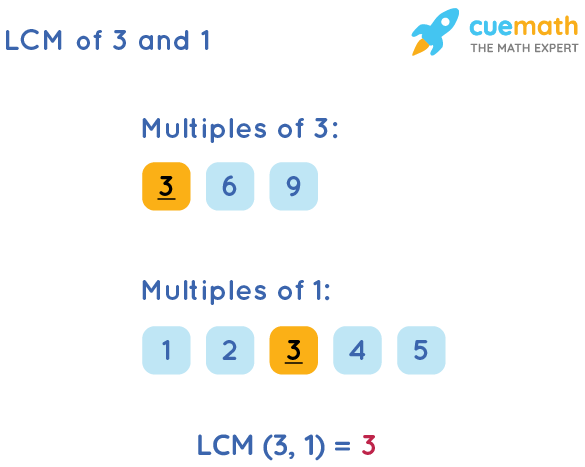LCM of 3 and 1
LCM of 3 and 1 is the smallest number among all common multiples of 3 and 1. The first few multiples of 3 and 1 are (3, 6, 9, 12, 15, 18, 21, . . . ) and (1, 2, 3, 4, 5, . . . ) respectively. There are 2 commonly used methods to find LCM of 3 and 1 - by division method, and by listing multiples.
| 1. | LCM of 3 and 1 |
| 2. | List of Methods |
| 3. | Solved Examples |
| 4. | FAQs |
What is the LCM of 3 and 1?
Answer: LCM of 3 and 1 is 3.

Explanation:
The LCM of two non-zero integers, x(3) and y(1), is the smallest positive integer m(3) that is divisible by both x(3) and y(1) without any remainder.
Methods to Find LCM of 3 and 1
Let's look at the different methods for finding the LCM of 3 and 1.
- By Division Method
- By Listing Multiples
LCM of 3 and 1 by Division Method
To calculate the LCM of 3 and 1 by the division method, we will divide the numbers(3, 1) by their prime factors, as long as at least one of the numbers is evenly divisible by a prime number. The product of these divisors gives the LCM of 3 and 1.
- Step 1: Find the smallest prime number that is a factor of at least one of the numbers, 3 and 1. Write this prime number(3) on the left of the given numbers(3 and 1), separated as per the ladder arrangement.
- Step 2: If any of the given numbers (3, 1) is a multiple of 3, divide it by 3 and write the quotient below it. Bring down any number that is not divisible by the prime number.
- Step 3: Since only 1s are left in the last row, we can stop here.
The LCM of 3 and 1 by division method is given as, LCM(3, 1) = 3.
LCM of 3 and 1 by Listing Multiples

To calculate the LCM of 3 and 1 by listing out the common multiples, we can follow the given below steps:
- Step 1: List a few multiples of 3 (3, 6, 9, 12, 15, 18, 21, . . . ) and 1 (1, 2, 3, 4, 5, . . . )
- Step 2: The common multiples from the multiples of 3 and 1 are 3, 6, . . .
- Step 3: The smallest common multiple of 3 and 1 is 3.
∴ The least common multiple of 3 and 1 = 3.
☛ Also Check:
- LCM of 3 and 10 - 30
- LCM of 20, 25 and 30 - 300
- LCM of 7 and 17 - 119
- LCM of 3 and 13 - 39
- LCM of 3, 5 and 11 - 165
- LCM of 16, 18 and 24 - 144
- LCM of 3 and 5 - 15
LCM of 3 and 1 Examples
-
Example 2: The product of two numbers is 3. If their GCD is 1, what is their LCM?
Solution:
Given: GCD = 1
product of numbers = 3
∵ LCM × GCD = product of numbers
⇒ LCM = Product/GCD = 3/1
Therefore, the LCM is 3.
The probable combination for the given case is LCM(3, 1) = 3. -
Example 3: Find the smallest number that is divisible by 3 and 1 exactly.
Solution:
The smallest number that is divisible by 3 and 1 exactly is their LCM.
⇒ Multiples of 3 and 1:- Multiples of 3 = 3, 6, 9, 12, 15, 18, 21, . . .
- Multiples of 1 = 1, 2, 3, 4, 5, 6, 7, . . .
Therefore, the LCM of 3 and 1 is 3.

FAQs on LCM of 3 and 1
What is the LCM of 3 and 1?
The LCM of 3 and 1 is 3. To find the least common multiple (LCM) of 3 and 1, we need to find the multiples of 3 and 1 (multiples of 3 = 3, 6, 9, 12, . . .; multiples of 1 = 1, 2, 3, 4, . . .) and choose the smallest multiple that is exactly divisible by 3 and 1, i.e., 3.
What is the Relation Between GCF and LCM of 3, 1?
The following equation can be used to express the relation between GCF and LCM of 3 and 1, i.e. GCF × LCM = 3 × 1.
If the LCM of 1 and 3 is 3, Find its GCF.
LCM(1, 3) × GCF(1, 3) = 1 × 3
Since the LCM of 1 and 3 = 3
⇒ 3 × GCF(1, 3) = 3
Therefore, the GCF = 3/3 = 1.
What is the Least Perfect Square Divisible by 3 and 1?
The least number divisible by 3 and 1 = LCM(3, 1)
LCM of 3 and 1 = 3
⇒ Least perfect square divisible by each 3 and 1 = 3 × 3 = 9 [Square root of 9 = √9 = ±3]
Therefore, 9 is the required number.
What are the Methods to Find LCM of 1 and 5?
The commonly used methods to find the LCM of 1 and 5 are:
- Listing Multiples
- Division Method
visual curriculum